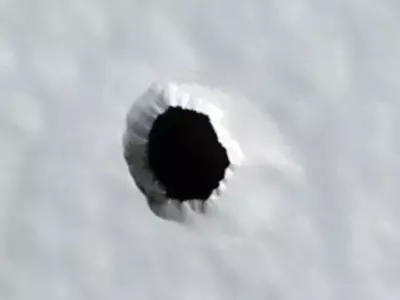Mysterious Hole Found on Mars 24
Mysterious Hole Found on Mars
On the surface of Mars, a fascinating and enigmatic hole has been photographed by NASA’s Mars Reconnaissance Orbiter (MRO) camera using data from the High-Resolution Imaging Science Experiment (HiRISE) instrument. Situated in the Arsia Mons region, this unusual, Mysterious Hole Found on Mars has scientists wondering where it came from and what mysteries it might conceal below the Martian surface.

Finding and Placement
This mysterious pit lies beneath Arsia Mons, one of Mars’ three major inactive volcanoes. There is ample evidence of volcanic activity in the Arsia Mons region, which implies that the region’s geological past may hold secrets regarding the hole’s creation.
While the pit is only a few meters across, its appearance begs many concerns regarding the mechanisms that formed it in the first place.
A sidewall is seen in an image of one of the pits, indicating that it is cylindrical and might not lead to a cave. These kinds of holes, known as “pit craters,” are rather typical on Hawaiian volcanoes. The Arsia Mons pit in the picture is 178 meters deep, but its depths on Earth vary from six to 186 meters.
These kinds of pits are fascinating to scientists because they could reveal information about previous Marsian life and help assess if microbial life is still present there.
Concepts and Conjectures
The most widely accepted theory, out of the several that have been put forth, is that this hole might be a skylight leading into an underground lava tube. This theory is based on observations made on Earth, where comparable formations have been found in volcanic areas like as Hawaii. When a lava tube’s ceiling collapses, revealing the underground tunnel, an opening known as a skylight is created.
The consequences for Mars exploration are significant if this idea is correct. Future settlers on Mars may find refuge in the planet’s lava tubes, which provide defense against radiation, severe temperatures, and dust storms.
Another intriguing possibility is that there may be more lava tubes on Mars than there are on Earth. Larger and more stable subterranean habitats could be possible on Mars thanks to its lower gravity, making them ideal for long-term residence and scientific research.
You may like NASA selected crew for Mars mission
Other Theories
Even if the lava tube theory makes sense, there are other possibilities that should be taken into account. The hole can just be a pit created by volcanic or tectonic activity. On Earth, these kinds of pits are not unusual; they are frequently caused by the collapse of ground over gaps left by volcanic activity. This idea is still feasible, especially considering that the Arsia Mons region is volcanic in nature.
Scientific Research
Scientists are still figuring out the specifics of this unexplained hole, despite these fascinating possibilities. The HiRISE camera’s high-resolution imagery offers comprehensive views, but more research is necessary to completely comprehend the pit’s development. With more sophisticated tools, future Mars missions could investigate these features in greater detail and provide fresh information about the planet’s deep architecture and geological past.
Consequences for Human Investigating
Such a hole’s finding will have a big impact on future Mars exploration efforts. It might indicate possible locations for human habitation if it is verified as a skylight to a lava tube. Future Mars colonies should consider lava tubes because they provide a natural defense against the harsh Martian climate. They might also present important scientific opportunities, enabling researchers to investigate Martian geology and look for traces of prehistoric life in a comparatively unaltered setting.
This information is collected from Universe Magazine and WION News.
Is there a bigger subterranean cavern accessible from this hole on Mars?
One may never completely rule out the idea that this hole leads to a larger subterranean cavern. The lava tube may stretch for a significant distance and provide a natural tunnel beneath the Martian surface if the opening is, in fact, a skylight into a lava tube.
How big is the hole in Mars?
The camera captured a massive hole that appeared to lead into a sizable underground cavern on Pavonis Mons, a massive shield volcano in the Tharsis region of the volcanic mountains. According to additional investigation, the cavern beneath the hole is around 20 meters (66 feet) deep, and the hole’s aperture is about 35 meters (115 feet) in diameter.
What are the mysterious holes on Mars?
One major indicator that they are most likely related to volcanic activity on Mars is the existence of these so-called holes on the sides of volcanoes. Lava flows out of subterranean channels that originate from volcanoes; these channels eventually empty as the volcano ages. A long, underground tube is left in its wake.




